Neel Shelat looks at one of La Liga’s in form sides and their unusual approach in possession
It would not be too much of a stretch to suggest that Basque football is in its best moment since the 1980s, when the region’s two major clubs won multiple La Liga titles. While neither seem to be seriously challenging Barcelona and Real Madrid this season, both Athletic Club and Real Sociedad are having great seasons in their own right.
We have already looked at how Athletic Club have found success this season through a style of play that can be described as controlled directness. Their near neighbours Real Sociedad also seek to establish control in their matches but they do things very differently, as we will explore.
Unlike Athletic Club, Real Sociedad do not have a policy of only employing players from the Basque region, but the man currently steering them to success just so happens to be a local. Imanol Alguacil started his senior career at Real Sociedad having grown up playing in their youth academy and went on to make over 110 appearances for the senior team before moving on.
His coaching career also began at the club’s youth academy in 2011. He soon moved up to an assistant role with the B team, before fully taking charge of the squad in 2014. After a brief interim spell in charge of the senior team in early 2018, he was given the role on a long-term basis at the end of the year, and he has been there since.
A quick glance at Sociedad’s xG trendline since Alguacil shows how much of a success he has been. When the now-51-year-old manager took charge, Sociedad’s xGD was close to zero. After a bit of while (which included a disrupted first full season in charge thanks to the COVID-19 pandemic), he really started to get his side firing. At present, their attack has slumped a little bit (although it remains good), but their defensive numbers are as good as they’ve ever been in the last few years.
Next, let us take a look at Alguacil’s Coach ID radar to understand what sort of style of play he prefers. Regardless of the level of opposition, his team’s approach to matches does not seem to change a lot. They really love their deep circulation (and consequently possession as well), do not play long balls which means they progress through the thirds patiently, and their lack of emphasis on wing play seems to indicate that they like to play through the middle instead.
This is quite interesting in the context of this season. When Alguacil first took charge, he mainly used a 4-2-3-1 or 4-3-3 formation, but last season, he started dabbling with a 4-4-2 diamond (4-1-2-1-2), which he has fully switched to this season.
Of course, the natural characteristics of this formation mean that it lends itself to most of Alguacil’s stylistic preferences, but it is quite interesting to see a patient possession-based team using this formation. Usually, the 4-4-2 diamond formation is not conducive to this style of play due to how centrally congested and lacking in width it is, which makes it easier to defend against.
However, Real Sociedad have players of the technical and tactical capabilities in their squad to pair up this formation with Alguacil’s preferred style of play. Therefore, they are a very interesting case study in controlling possession with a 4-4-2 diamond.
Goalkeeper Involvement in Deep Build-Up
Let us start by looking at how Real Sociedad are set up at the very start, in the deepest phase of possession. Their build-up structure is made up of six players: the goalkeeper, back four, and defensive midfielder Martín Zubimendi.
Their positioning can be described as a 3-3 structure. The centre-backs split either side of the goalkeeper but all three are usually inside the penalty area. Zubimendi can usually be spotted close to the edge of the D, while the two full-backs are vertically alongside him but start as close to the touchline as possible.
As the above still shows, the rest of the team is much higher up the pitch, closer to the halfway line. The idea behind that is to pin the opposition defence at halfway and leave open space between the lines. The two number eights may drop deep to offer a passing option sometimes, but mostly, it is up to these six players to get out of the defensive third.
They start by trying to lure the opposition attackers forward and further enlarge that space between the lines. In order to do so, the back-three keep the ball in the box for a good while. Once the opposition front line does start stepping up, they look to release the ball behind them.
Since he is the most central player in this structure, goalkeeper Álex Remiro’s ball-playing abilities are key to Real Sociedad’s build-ups. He helps bait the press by standing on the ball (even using sole touches) or playing it across to his centre-backs. Then, his passmap shows the variety of balls he plays to help his team beat the press, including chipped balls out to the full-backs to release them into space behind the opposition attackers, passes into midfield or even long balls to the front line.
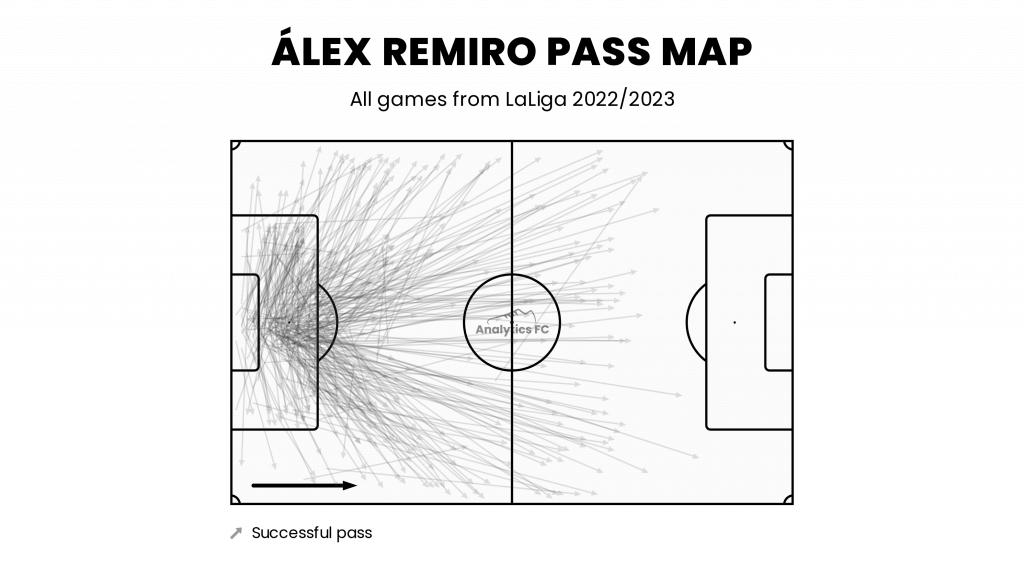
Given the fact that their front five is all congested in central areas of the pitch in this case, long balls are not a bad idea at all since they have a lot of players positioned to win the loose ball. Additionally, the player profiles in their front two are conducive to this style of play – one is usually an aerially strong target man, while the other is a quick player who can run in behind.
Irrespective of whether they play out through long balls, chipped balls to the full-backs or passes into midfield, one thing is sure: pressing Real Sociedad is not a very fruitful exercise in most cases. The compactness of their six-player build-up structure combined with the advanced positioning of the remaining five mean that the opposition cannot afford to commit too many bodies forward, and thereby allow La Real to have a numerical advantage in the first phase of possession.
In this phase, Sociedad’s use of a narrow midfield diamond is beneficial if anything (as they can help win second balls as previously discussed), so what is perhaps more interesting is how they behave further up the pitch.
Mixing Sufficient Width with Midfield Quality
Real Sociedad’s playing style has been described by Rahul Iyer as “what happens if you play five technicians with a battering ram CF”, and that really is a very succinct way of putting things. A quick look at the average positions of their first-choice XI shows this, as they have a very congested midfield with big Alexander Sørloth up top.
We will get on to how the midfield magicians operate, but first let us explore how Real Sociedad manage to add enough width to their attacks because solely playing through the middle would be quite ineffective and easily defended against. So, they have a couple of tricks to mix things up.
Their shape in settled possession can be described as a 4-1-Central Cluster-1. The full-backs tend to start pretty deep, with Zubimendi isolated in defensive midfield. The two number eights do not go much wider than the halfspaces, the number 10 and second striker are free to take up a central position between the lines, and Sørloth can always be found on the shoulder of the last defender.
The simplest way to add width to this structure is to ask the number eights to move out wide. That is exactly what they do when the ball is played out to a full-back, as can be seen in the above snapshot. After receiving out wide, they can either take the ball forward themselves or find a passing option available infield.
The alternative is to do what is often seen in sides using a simple 4-4-2 diamond formation – push the full-backs forward. However, Sociedad do things a little differently. They use what can be described as a steering wheel system in Louis van Gaal’s words so when one full-backs gets forward, the other stays deep and even joins the back line.
Often at the same time, the second striker (most often Takefusa Kubo) moves out to the opposite wing, meaning Sociedad have width on both flanks. In this manner, they can stretch opposition defences laterally even though they use such a narrow formation.
Of course, most of their play is channelled through their midfielders anyway, so they are their most important players in possession.
As mentioned above, Zubimendi is mostly isolated in defensive midfield, so he is the key link between the back line and the rest of the side. The 23-year-old Spaniard can be seen moving from side to side to continuously offer himself as a passing option and quickly move the ball on. Sometimes, he even drops in between the centre-backs. His pass map shows his all-action involvement.

At times, he does receive a bit of support from one of the number eights, as is the case in the previous match snapshot. Mikel Merino is the one providing this most often, so he is joint-top for progressive passes in the squad alongside Zubimendi.

On the right of midfield, summer signing Brais Méndez has been in the form of his life. He too is involved in progressing the ball a fair deal, through passing, receiving as well as carrying. In addition to that, he has been a regular presence at the sharp end. The ex-Celta Vigo midfielder already has seven league goals, most of which have been scored thanks to runs and finishes like this.
? ?? ????????? ?
— LaLiga (@LaLiga) September 1, 2022
? ?? ???? ?
? ?? ??? de Brais Méndez ?
? @RealSociedad ?#LaLigaSantander pic.twitter.com/RPF8P46jZA
At the tip of the diamond, Sociedad have a certain David Silva. The ex-Manchester City midfielder may be 36 years old, but he has definitely still got it. He has not lost even an ounce of his spatial intelligence, so he has received the second-most progressive passes in La Real’s squad this season. Everyone knows how good he is at releasing passes on the half-turn, so it should be no surprise that he has made more passes into the penalty area than any of his teammates.

One of the most crucial players within Sociedad’s system is Takefusa Kubo. The Japanese international’s role is perhaps the most varied so it also gives him a lot of positional freedom. His previous employers in Spain, which include Mallorca, Villarreal and Getafe, all tried to use him as a winger and failed to get the most out of him. Alguacil, however, uses him as a second striker, but he does drift wide at times as we saw previously and can also be seen drifting between the lines in the centre of the pitch to then make runs in behind.
In this role, he does not always see a lot of the ball (averaging just over 40 touches per 90), but when he does get it, he usually makes something of it. He is quite direct with the ball at his feet, so he is always looking for a killer pass or shooting opportunity, or brings it closer to the goal.
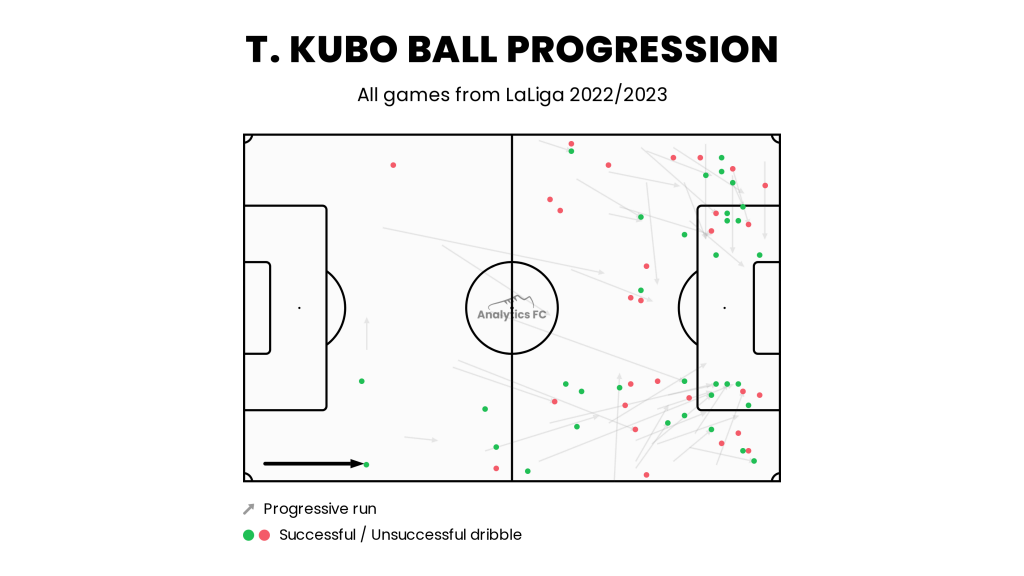
Given this cluster of technically excellent central midfielders and the freely drifting Kubo, it should be much of a surprise to see that most of Socidad’s chances are created through the middle. The full-backs do push up at times as we previously explored, but their job is to mainly stretch the opposition defence rather than receive the ball. That is why Sociedad have attempted the third-fewest crosses among all La Liga teams this season.
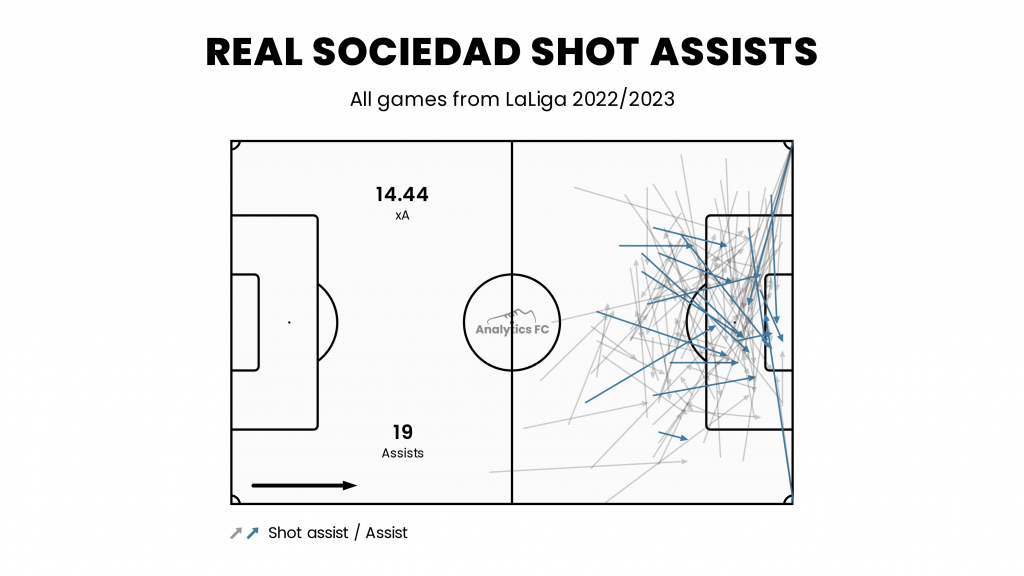
Of course, the final piece of the puzzle is the person who finishes these chances. That is Alexander Sørloth, who has been dealing in high-quality chances only this season. The Norwegian international has eight league goals from 29 shots, with an average npxG/shot value of 0.17. That is the second-highest in the league among players who have attempted 25 or more shots, only behind Robert Lewandowski.
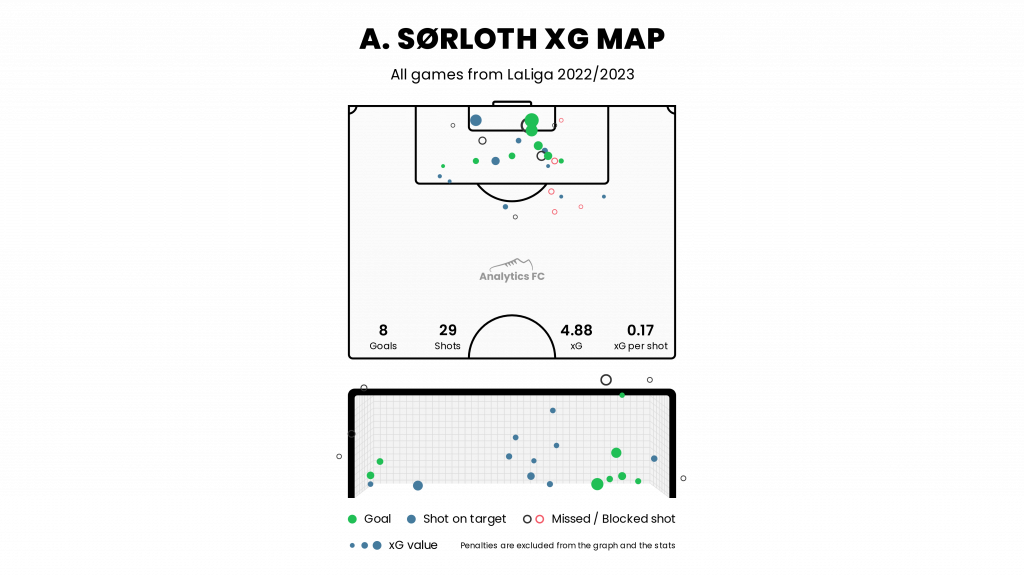
So, the answer to the question “what happens if you play five technicians with a battering ram CF” is that you get a lot of goals, and some very nice ones at that.
???? ??????? ?? ????? ??????, @RealSociedad… #LaLigaSantander | #LaLigaHighlights pic.twitter.com/KoPfz8V9tf
— LaLiga (@LaLiga) January 3, 2023
An additional dimension of Sociedad’s play is that they like to defend with the ball too. This means that even when they have a lead, they are not happy to cede possession but instead focus on keeping it more carefully, circulating the ball around the back and taking fewer risks in their pass selection. However, they are also well-equipped to win the ball back when they lose it.
Counterpressing and High Block Defending
The most obvious advantage of the 4-4-2 diamond’s narrowness is that it really benefits a team’s rest defence and counterpressing. The reason behind that is quite obvious – having more players in the middle of the pitch makes it tougher for the opposition to immediately play forward after turnovers, and also makes it likelier that the team using the 4-4-2 diamond has a numerical advantage in the region. So, Real Sociedad have the second-highest Gegenpressing Intensity in La Liga at 56% this season.
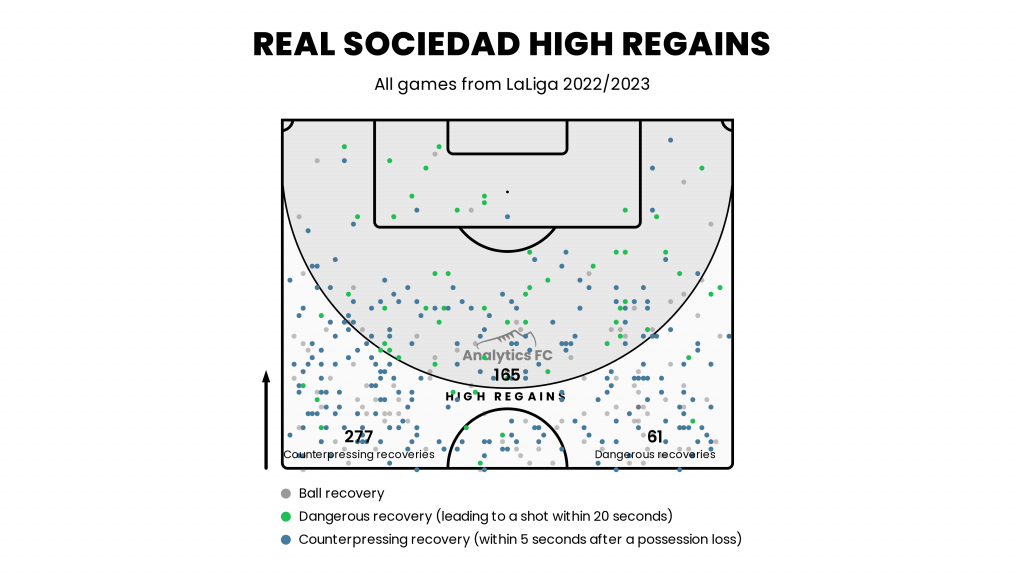
The second advantage of having a lot of players in central areas while counterpressing is that Sociedad immediately have a number of dangerous runners after recovering possession high up the pitch. This is why they have the third-most shot-ending and goal-ending high turnovers in the league at 28 and 4 respectively.
The first assist in this clip is a great example of that:
???????
— LaLiga (@LaLiga) January 12, 2023
??? ¡Las '7?' ??????????? del 'Conde' @mikelmerino1 con la @RealSociedad esa temporada en #LaLigaSantander!#LaLigaHighlights pic.twitter.com/YyipZOOGKj
The other way in which Sociedad generate high turnovers is, of course, by pressing. Indeed, their defensive setup is quite intriguing. They start by adopting a traditional 4-4-2 diamond structure in a high block, with the number 10 on the opposition’s defensive midfielder and the front two prepared to press the centre-backs.
Of course, the exact make-up of the rest of the midfield varies depending on what sort of system the opposition team is using, but generally, we see a fair deal of player-marking. The big question mark, of course, is how to deal with the opponents’ full-backs or wing-backs. Sociedad’s answer is to send their number eight to press that player when they receive the ball.
Given the fact that the number eight’s run begins from a very central area, the opposition’s midfielders are mostly left in the covershadow, so the full-back has to either go down the line and risk losing possession or go backwards, which is when the press is fully instigated. This strategy has helped Sociedad put up the joint-best PPDA (Passes Allowed per Defensive Action) in the league this season at 8.9.
If the opposition does manage to push La Real back, their shape collapses into a compact 4-3-1-2/4-3-3. One key feature of their defensive system that remains unchanged, though, is their extremely high defensive line. Their average defensive line height in La Liga this season is 48.81 yards, which makes it the second highest in the division.
Of course, there are certain match-specific tweaks that Alguacil makes to his side’s defensive shape. For example, against a double pivot, one of the number eights may push up alongside the number 10 to mark both opposition defensive midfielders. In other cases where the opponents use a front-five in possession, Zubimendi can be seen dropping into the back line to prevent it from being overloaded. However, the basic principles of defending with a high line, keeping the midfield compact and initiating the press after the opponents play the ball out wide remain constant.
Discussion and Conclusion
Clearly, Alguacil has evolved very well at Real Sociedad. The club are definitely playing the best football of his tenure this season, and they are doing so with a unique and interesting approach to a relatively popular style of play. The 4-4-2 diamond probably is not the best way to go about playing a possession-dominant approach and La Real do feel its limitations in the lack of width to their attacks, but given their squad composition, it does seem to be the best system for them in the sense that it gets the most out of their players.
At the time of writing, Sociedad are third in La Liga and nine points clear of the side in fourth but within three of second-placed Real Madrid, whom they face next. It seems unlikely that they can continue to keep step with the top two till the end of the season, but the underlying numbers definitely suggest that they should be able to hold on to a Champions League spot. The last time they qualified for Europe’s most elite club competition was a decade ago, so this would be a huge success for La Real.
Stats courtesy Transfermarkt, Opta via Fbref and Opta Analyst, Soccerment, Markstats and Vizz App.
Header image copyright IMAGO / AFLOSPORT














